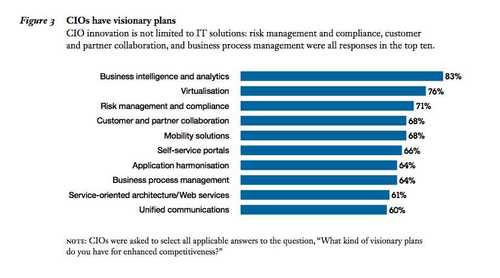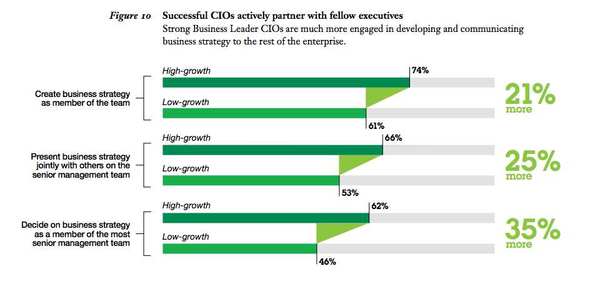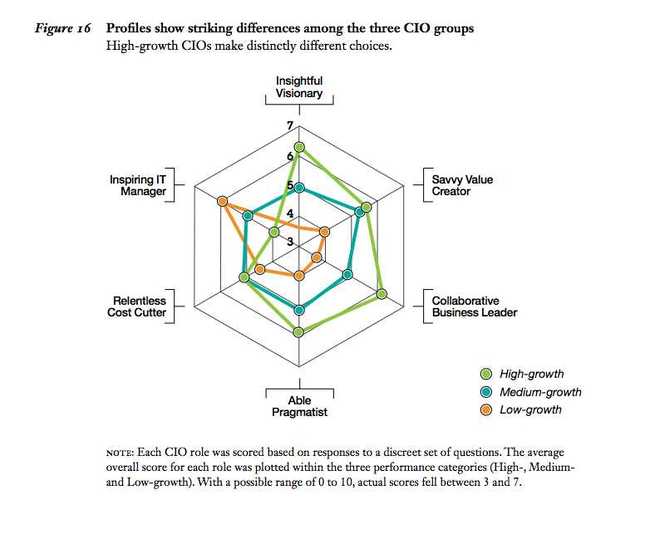CIO full-face and profile - IBM version
Caught the eye the results of a survey conducted by IBM 2.5 thousand. CIO. Interviewed 19 industries around the world, including in Russia. The study was carried out, apparently, in the form of a personal conversation, with a minimal inclusion of formalized questionnaires. The results were divided into three groups of companies: fast-growing, mid-range and slow-growing (this is apparently the minimum level for IBM customers), and compared which CIOs work and how they live.
Some of the results are fairly obvious and duplicated from survey to survey, but something seemed curious.
The closest implementation priorities for the IT directors surveyed by IBM are business intelligence (by a wide margin) and virtualization. It’s clear about virtualization, but it seemed that everyone ate a couple of business analytics a couple of years ago. It turns out that no. And for some reason, portals and other web solutions occupy not very high places, which today also looks rather strange.

It seems almost fantastic that the CIO respondents think about the clients of their native company and how to more closely engage them in interactive interaction, quickly receive requests / wishes / information from customers, and modify their systems in accordance with customer needs. In the next five years, 87% of CIOs of fast-growing companies will implement solutions to improve this interaction. In slowly growing companies, this figure is 70%, which is actually a lot. According to my impressions, in Russia, IT directors still do not always manage to smoothly interact with business units of their own company, and only think about customers ... No, they, of course, know about the existence of such a concept as a client, but in order to focus on him in IT plans - before that, it seems, still to grow and grow.
Be that as it may, the CIO from the IBM survey suggests that such a customer focus will require high integration and data transparency, so 68% of the “fast-growing” and 44% of the “slow-growing” plan to purchase or develop the appropriate software.
Kau found out IBM, 14% of CIO’s working hours are “cost-cutting” (I imagine a gloomy CIO, painfully deleting the necessary articles from the IT budget). According to respondents, one of the best ways to reduce costs is to tightly centralize the infrastructure - not necessarily in the physical sense, but rather in terms of management. 3/4 of the respondents plan to centralize in the next 5 years. Another item in the cost-cutting program is the introduction of fully standardized processes; “Fast-growing” are 22% more likely than “slow-growing” to plan such standardization.
A significant number of CIOs claim that they are somehow involved in the formation of the strategy. True, as follows from the diagram below, strategic decisions allow a much smaller number of respondents.

Interestingly, according to CIO, the company's business model should be unique, difficult to copy, and CIOs are going to implement such solutions that support and enhance corporate uniqueness. It is not clear where they are going to find them in the consolidating IT market, but the very tendency to move away from mass copying of successful models and processes may turn out to be interesting in some (I think, not short-term) perspective.
Finally, IBM cites CIO role profiles in its report based on the growth rate of the companies in which they operate.

As you can see, in slowly growing companies, CIO is more likely to focus on the role of an IT manager, maintaining order in the current infrastructure and calmly managing its department, while in fast growing companies, CIO sees itself as an innovator and business leader.
In conclusion, IBM gives some tips on how you can improve your own professional profile. It is long to retell, and the full version of the report (in English, registration is needed) can be found here .
Some of the results are fairly obvious and duplicated from survey to survey, but something seemed curious.
The closest implementation priorities for the IT directors surveyed by IBM are business intelligence (by a wide margin) and virtualization. It’s clear about virtualization, but it seemed that everyone ate a couple of business analytics a couple of years ago. It turns out that no. And for some reason, portals and other web solutions occupy not very high places, which today also looks rather strange.

It seems almost fantastic that the CIO respondents think about the clients of their native company and how to more closely engage them in interactive interaction, quickly receive requests / wishes / information from customers, and modify their systems in accordance with customer needs. In the next five years, 87% of CIOs of fast-growing companies will implement solutions to improve this interaction. In slowly growing companies, this figure is 70%, which is actually a lot. According to my impressions, in Russia, IT directors still do not always manage to smoothly interact with business units of their own company, and only think about customers ... No, they, of course, know about the existence of such a concept as a client, but in order to focus on him in IT plans - before that, it seems, still to grow and grow.
Be that as it may, the CIO from the IBM survey suggests that such a customer focus will require high integration and data transparency, so 68% of the “fast-growing” and 44% of the “slow-growing” plan to purchase or develop the appropriate software.
Kau found out IBM, 14% of CIO’s working hours are “cost-cutting” (I imagine a gloomy CIO, painfully deleting the necessary articles from the IT budget). According to respondents, one of the best ways to reduce costs is to tightly centralize the infrastructure - not necessarily in the physical sense, but rather in terms of management. 3/4 of the respondents plan to centralize in the next 5 years. Another item in the cost-cutting program is the introduction of fully standardized processes; “Fast-growing” are 22% more likely than “slow-growing” to plan such standardization.
A significant number of CIOs claim that they are somehow involved in the formation of the strategy. True, as follows from the diagram below, strategic decisions allow a much smaller number of respondents.

Interestingly, according to CIO, the company's business model should be unique, difficult to copy, and CIOs are going to implement such solutions that support and enhance corporate uniqueness. It is not clear where they are going to find them in the consolidating IT market, but the very tendency to move away from mass copying of successful models and processes may turn out to be interesting in some (I think, not short-term) perspective.
Finally, IBM cites CIO role profiles in its report based on the growth rate of the companies in which they operate.

As you can see, in slowly growing companies, CIO is more likely to focus on the role of an IT manager, maintaining order in the current infrastructure and calmly managing its department, while in fast growing companies, CIO sees itself as an innovator and business leader.
In conclusion, IBM gives some tips on how you can improve your own professional profile. It is long to retell, and the full version of the report (in English, registration is needed) can be found here .
